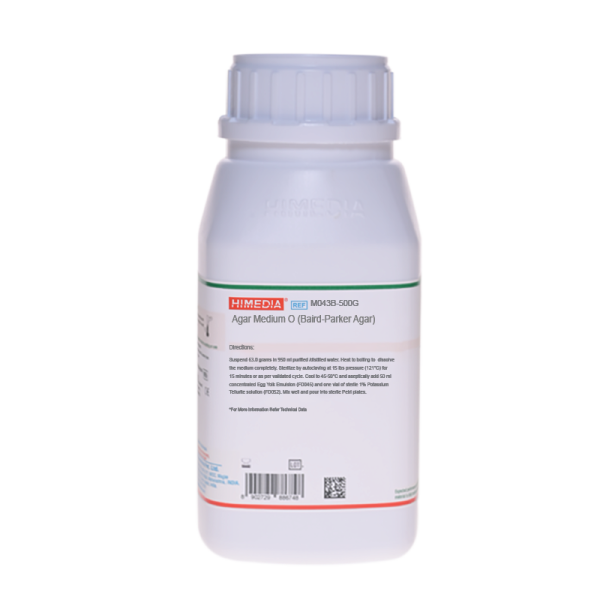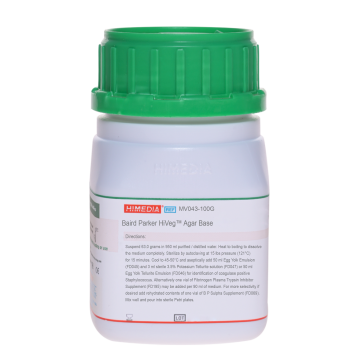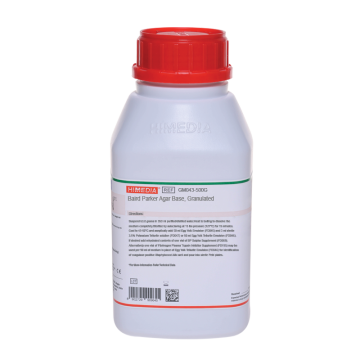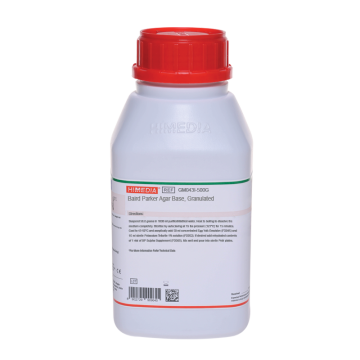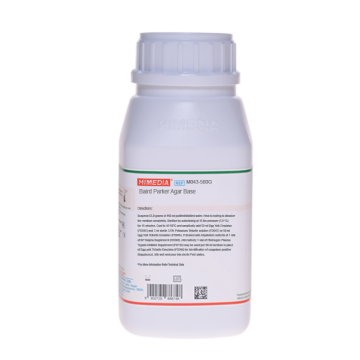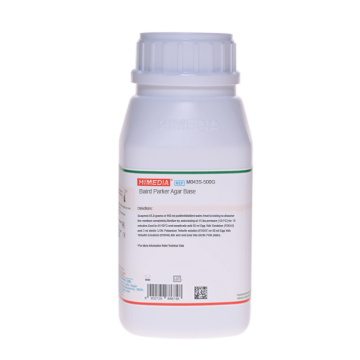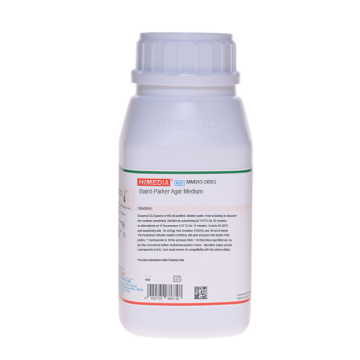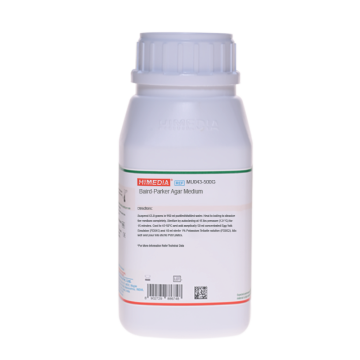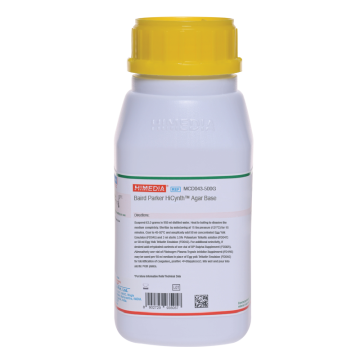 Your enquiry has been submitted
Your enquiry has been submitted
Agar Medium O (Baird Parker Agar)
Intended use
Baird-Parker Agar is recommended for the isolation and enumeration of coagulase positive Staphylococci from food and other materials in accordance with British Pharmacopoeia.
Composition**
| Ingredients | Gms / Litre |
|---|---|
| Tryptone ## | 10.000 |
| HM Peptone B# | 5.000 |
| Yeast extract | 1.000 |
| Glycine | 12.000 |
| Sodium pyruvate | 10.000 |
| Lithium chloride | 5.000 |
| Agar | 20.000 |
| pH after sterilization | 6.8±0.2 |
**Formula adjusted, standardized to suit performance parameters
## Pancreatic digest of casein # Equivalent to Beef extract
Directions
Suspend 63.0 grams in 950 ml purified/distilled water. Heat to boiling to dissolve the medium completely. Sterilize by autoclaving at 15 lbs pressure (121°C) for 15 minutes. Cool to 45-50°C and add aseptically 50 ml concentrated Egg Yolk Emulsion (FD045) and 10 ml sterile 1% Potassium Tellurite solution (FD052). Mix well before pouring into sterile Petri plates
Principle And Interpretation
This medium is cited as Agar medium O in British Pharmacopoeia, 2009 (4) recommended for isolation and enumeration of coagulase positive S. aureus. This medium was developed by Baird-Parker (2,3) from the Tellurite-glycine formulation of Zebovitz et.al.(11) for isolation of Staphylococcus aureus from foods. Staphylococcus species are common contaminants in food, dairy, pharmaceutical and cosmetics related products (5). This medium is recommended for sterility checking of materials to detect Staphylococcus aureus. Baird Parker medium was reported to be the best medium for selective detection of coagulase positive and entero-toxigenic Staphylococcus(9). This medium was found to be less inhibitory to Staphylococcus aureus than other media, at the same time being more selective (1,10). Subsequently it was officially adapted by the AOAC and British Pharmacopoeia (4,8).
HM Peptone B, yeast extract and tryptone provide essential nitrogeneous and carbonaceous compounds, long chain amino acids, mineral, vitamin and other growth requirements. Sodium pyruvate protects injured cells and helps recovery. Lithium chloride and potassium tellurite inhibit most of contaminating microflora except Staphylococcus aureus. Glycine, pyruvate enhances growth of Staphylococcus. With the addition of egg yolk the medium becomes yellow and opaque. Glycine neutralizes aldehyde, while egg yolk neutralizes phenolic compounds, if any, in the test samples. Proteolytic bacteria produce a clear zone around colony in egg yolk containing media also known as Lecithinase reaction. A clear zone and grey-black colonies on this medium are diagnostic for coagulase positive Staphylococci. Upon further incubation, an opaque zone is developed around colonies, which can be due to lipolytic activity. Identity of Staphylococcus aureus isolated on Baird-Parker Agar must be confirmed with a coagulase reaction and deoxyribonuclease test. The sterility of product is confirmed by absence of growth of Staphylococcus aureus on this medium.
Type of specimen
Food samples; Pharmaceutical samples.
Specimen Collection and Handling
For dietary and pharmaceutical samples, follow appropriate techniques for sample collection & processing as per guidelines (4,5). After use, contaminated materials must be sterilized by autoclaving before discarding.
Warning and Precautions
Read the label before opening the container. Wear protective gloves/protective clothing/eye protection/face protection. Follow good microbiological lab practices while handling specimens and culture. Standard precautions as per established guidelines should be followed while handling specimens. Safety guidelines may be referred in individual safety data sheets.
Limitations
- Though the medium is recommended for detection of coagulase positive Staphylococcus aureus, other bacteria may grow.
- Individual organisms differ in their growth requirement and may show variable growth patterns on the medium
- Each lot of the medium has been tested with the standard strains, slight variation in growth may be observed depending on the source from where the organism has been isolated.
Performance and Evaluation
Performance of the medium is expected when used as per the direction on the label within the expiry period when stored at recommended temperature.
Quality Control
Appearance: Cream to yellow homogeneous free flowing powder
Gelling: Firm, comparable with 2.0% agar gel.
Colour and Clarity of prepared medium: Basal medium: Yellow coloured clear to slightly opalescent gel. After addition of Egg Yolk Emulsion and Tellurite Emulsion: Yellow coloured opaque gel forms in Petri plates.
Reaction: After sterilization, reaction of 6.3% w/v aqueous solution. pH : 6.8±0.2
pH: 6.60-7.00
Cultural Response
Growth Promotion is carried out in accordance with BP. Cultural response was observed after an incubation at 35-37°C for 18-72 hours. Recovery rate is considered as 100% for bacteria growth on Soybean Casein Digest Agar.
| Organism | Inoculum (CFU) | Growth | Observed Lot value (CFU) | Recovery | Colour of colony | Lecithinase |
|---|---|---|---|---|---|---|
| Growth Promoting | ||||||
| Staphylococcus aureus subsp. aureus ATCC 6538 (00032*) | 50-100 | luxuriant | 25-100 | >=50% | grey-black shiny | Positive, opaque zone around the colony |
| Additional Microbiological testing | ||||||
| Staphylococcus aureus subsp. aureus ATCC 25923 (00034*) | 50-100 | luxuriant | 25-100 | >=50% | grey-black shiny | Positive, opaque zone around the colony |
| Proteus mirabilis ATCC 25933 | 50-100 | good - luxuriant | 25 -100 | >=50% | brown - black | Negative |
| Micrococcus luteus ATCC 10240 | 50-100 | poor - good | 15-40 | 30-40% | shades of brown-black (very small) | Negative |
| Staphylococcus epidermidis ATCC 12228 (00036*) | 50-100 | poor - good | 15-40 | 30-40% | black | Negative |
| Bacillus subtilis subsp. spizizenii ATCC 6633 (00003*) | 50-100 | none - poor | 0-10 | 0-10% | dark brown matt | Negative |
| Escherichia coli ATCC 8739 (00012*) | 50-100 | none- poor | 0-10 | 0-10% | large brown black | Negative |
| Escherichia coli ATCC 25922 (00034*) | 50-100 | none- poor | 0-10 | 0-10% | large brown black | Negative |
| Escherichia coli NCTC 9002 | 50-100 | none- poor | 0-10 | 0-10% | large brown black | Negative |
Key: *Corresponding WDCM numbers.
Storage and Shelf Life
Store between 10-30°C in a tightly closed container and the prepared medium at 2 - 8°C. Use before expiry date on the label. On opening, product should be properly stored dry, after tightly capping the bottle in order to prevent lump formation due to the hygroscopic nature of the product. Improper storage of the product may lead to lump formation. Store in dry ventilated area protected from extremes of temperature and sources of ignition Seal the container tightly after use. Product performance is best if used within stated expiry period.
Disposal
User must ensure safe disposal by autoclaving and/or incineration of used or unusable preparations of this product. Follow established laboratory procedures in disposing of infectious materials and material that comes into contact with sample must be decontaminated and disposed of in accordance with current laboratory techniques (6,7).
Reference
- Baer, 1971, J.Assoc. Off. Anal. Chem., 54:732.
- Baird-Parker, A.C. 1962, J.Appl. Bact.,25: 12.
- Baird-Parker, A.C. and Davenport, E., 1965,J.Appl.Bact.,28: 390.
- British Pharmacopoeia, 2009, The Stationery office British Pharmacopoeia.
- FDA Bacteriological Analytical Manual, 2005, 18th ed., AOAC, Washington, DC.
- Isenberg, H.D. Clinical Microbiology Procedures Handbook 2nd Edition.
- Jorgensen, J.H., Pfaller, M.A., Carroll, K.C., Funke, G., Landry, M.L., Richter, S.S and Warnock., D.W. (2015) Manual of Clinical Microbiology, 11th Edition. Vol. 1.
- J. Assoc. off. Anal. Chem, 1971, 54:401.
- Niskanean A and Aalto M, App. Env. Microbiol., 1978, 35:1233
- Tardio and Baer, 1971, J.Assoc.Off. Anal. Chem., 54:728.
- Zebovitz, E., Evans J.B. & Niven C.F., (1955), J. Bact; 70:686.
| Product Name | Agar Medium O (Baird Parker Agar) |
|---|---|
| SKU | M043B |
| Product Type | Regular |
| Physical Form | Powder |
| Origin | Animal |
| Packaging type | HDPE |
| References | 1. Baird-Parker A. C., 1962, J. Appl. Bacteriol., 25:12. 2.Baird-Parker A. C. and Davenport E., 1965, J. Appl. Bacteriol., 28:390. 3.Zebovitz E., Evans J. B. and Niven C.F., 1955, J. Bacteriol., 70:686 . 4.Tardio and Baer, 1971, J. Assoc. Off. Anal. Chem., 54:728. 5.Baer, 1971, J. Assoc. Off. Anal. Chem., 54:732. 6.Assoc. off. Anal. Chem., 1971, 54:401. 7.Horwitz (Ed.), 2000, Official methods of analysis of AOAC International, 17th Ed., Vol. I., AOAC International,Gaithersburg, MD. 8.The United States Pharmacopoeia, 2018, The United States Pharmacopoeial Convention. Rockville, MD. 9.International Organization for Standardization (ISO), 1983, Draft ISO/DIS 6888. 10.Smith B. A. and Baird-Parker A.C., 1964, J. Appl. Bacteriol., 27:78. 11. Beckers N. J. et al, 1984, Can. J. Microbiol., 30:470.1 2.American Public Health Association, Standard Methods for the Examination of Dairy Products, 1978, 14th Ed., WashingtonD.C. 13.Salfinger Y., and Tortorello M.L. Fifth (Ed.), 2015, Compendium of Methods for the Microbiological Examination ofFoods, 5th Ed., American Public Health Association, Washington, D.C. 14..Wehr H. M. and Frank J. H., 2004, Standard Methods for the Microbiological Examination of Dairy Products, 17th Ed.,APHA Inc., Washington, D.C. 15.Isenberg, H.D. Clinical Microbiology Procedures Handb0ook. 2nd Edition. 16.Jorgensen,J.H., Pfaller , M.A., Carroll, K.C., Funke, G., Landry, M.L., Richter, S.S and Warnock., D.W. (2015)Manual of Clinical Microbiology, 11th Edition. Vol. 1. |
| Customized Product Available | No |



